 |
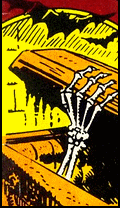 |
|
VAULT
OF EVIL,
WEIRD WONDER TALES,
AND
DAREDEVIL
BACK
TO BACK IN A
AUGUST
1974 MARVEL MULTI-MAGS
|
|
|
|
| |
|
| |
| In the early 1960s, the comic
book industry enjoyed a period of new creativity and
enthusiasm, generated by the hugely successful comeback
of the superhero genre. But there was bad news too - its
traditional sales points were starting to fail. The small
stores that had carried comic books for decades found
themselves pushed out of business by larger stores and
supermarkets, and newsagents started to view the low cover prices (and therefore
tiny profit margins) comics
had to offer as a
nuisance. The comic book industry desperately needed to open up new sales opportunities and
markets and tap into a new customer base. One place these potential buyers could be
found was the growing number of those very supermarkets
and chain stores. But in order to be able to sell comic
books at supermarkets, the product would have to be
adjusted.
|
| |
| By
looking at the logistics and displays of
these outlets, DC Comics came up with the
answer to breaking into this promising
new market: simply package several comic
books together in a transparent plastic
bag. The
result was a higher price per unit on
sale, which made the whole business of
stocking them much more worthwhile for
the seller. The simple packaging also
showed that the items were new and
untouched, while at the same time
blending in with most other goods sold at
supermarkets, which were also
conveniently packaged. Outlets
were even supplied with dedicated Comicpac
racks, enhancing the product appeal even
more as the packaged comic books could be
displayed
on rack hooks in an orderly and neat
fashion.
|
|
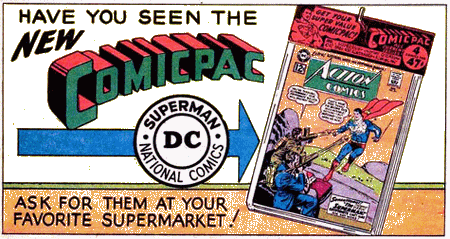 |
|
|
| |
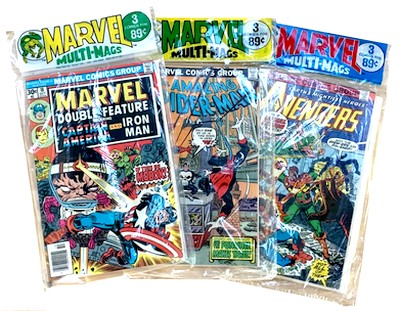
|
|
DC's
"comicpacks" were a success -
so much so that other publishers quickly
started to copy it. After a short series of Marvel
Multi-Mags in 1968/69,
the
House of Ideas fully embraced the
marketing concept as of the early 1970s,
selling multiple comic books packaged in
a sealed plastic bag to a customer base
they could hardly reach otherwise: people
shopping at supermarkets and large
grocery stores.
It didn't really matter therefore that
buying these three comic books in a
comicpack for say 74˘ (rather than from
a newsagent for 75˘
in that case)
clearly presented no real bargain - it
was the opportunity and convenience to
pick up a few comics at the same time
parents and adults did their general
shopping.
Neatly packaged,
it almost became an entirely different
class of commodity.
|
|
|
| |
|
| |
| The surge in popularity of superheroes in comic books
since the early 1960s had cooled off somewhat by the end
of the decade, and publishers and editors were looking to
expand into other genres. Horror was one of them, and it
proved popular enough to see a whole slew of titles
launched by several publishers. None, however, was
anywhere near as prolific as Marvel, who covered much of
the market with a barrage of different horror titles -
and this MARVEL MULTI-MAGS from
mid-1974 provides a glimpse into Marvel's haunts of
horror in the early 1970s. |
| |
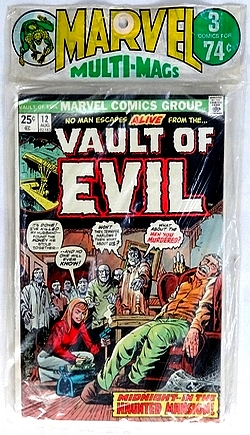 |
|
VAULT OF
EVIL #12,
WEIRD
WONDER TALES #5 and
DAREDEVIL
#112 are all issues
from the August 1974 cover date run.
This meant that they were
actually on sale at newsagents in May, although
there could be quite a delay in terms of actual
availability of MARVEL MULTI-MAGS
at some sales points of up to nine months
(Brevoort, 2007) - no real surprise, considering
the packaging and distribution process.
No
titles had permanent slots in the MARVEL MULTI-MAGS, although some did show
up in a reliably regular way.
Daredevil
was such a title, but Vault of Evil and Weird
Wonder Tales most definitely were not - in
fact, their presence in this
MULTI-MAGS is, at least based on
the data currently available, a singular
occurrence. In other words: no other issues of
those two titles are documented as having been
part of the selection of any MARVEL MULTI-MAGS other than this 1974
specimen.
|
|
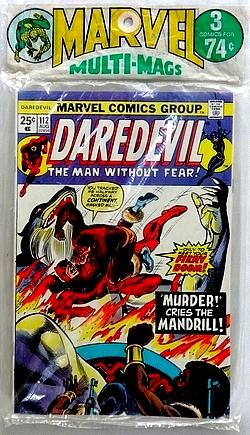 |
|
| |
| Somewhat surprisingly, Marvel's all-out venture into
the horror genre during the early and mid-1970s is vastly
under-represented in the MULTI-MAGS. |
| |
| This is all the more
surprising as the "Haunted House of
Ideas" came up with two very diverse
concepts on how to handle horror. The
innovative approach was to incorporate
classic gothic horror characters into
storylines not too far removed from the
superhero tales, giving birth to such
classic 1970s titles as Tomb of Dracula,
Ghost Rider, Werewolf by
Night, Man-Thing, and Frankenstein
Monster. The classic approach to
horror, however, was the anthology
format, where one issue would contain on
average four short tales of horror.
Initially Marvel produced original
material or adaptations of classic tales
for this format, but soon ran out of
editorial steam and artistic man-power
and thus reverted to simply reprinting
material from the 1950s. It was an easy
way to build up an enormous market
presence, dominate the shelves and
spinner-racks, and corner as much as
possible of the horror genre's popularity
at the time.
In 1973 alone,
Marvel launched six such anthology
titles: Crypt of Shadows, Beware,
Dead of Night, Uncanny Tales (later
re-titled Uncanny Tales from the
Grave) along with the two titles
featured in this
MARVEL
MULTI-MAGS,
Vault
of Evil and Weird Wonder Tales.
|
|
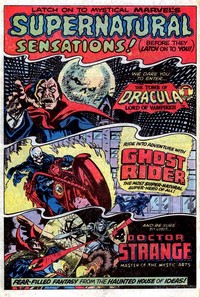 |
|
|
| |
| Data regarding Marvel's MULTI-MAGS is currently derived entirely
from known existing examples and unfortunately lacks any
systematic foundation that could be gained, for example,
from production or distribution lists. In that respect,
attempting to analyze MARVEL MULTI-MAGS could be likened to the task faced by an
archaeologist; the overall picture is based on inference
in an attempt to fill in the blanks and gaps. Things get even more muddled and
sketchy when looking at the early years of the 1970s.
Currently, only two examples of MARVEL MULTI-MAGS are documented each for 1972
and 1973, and the numbers only go up slightly for 1974
(four) and 1975 (seven). It is only as of 1976 (with
twenty known different MULTI-MAGS
examples) that the data becomes somewhat more stable and
allows for some amount of analysis.
Nonetheless it is very
clear that Marvel kept its horror titles in the MULTI-MAGS to a bare minimum, with the
only known inclusions to date being in
1972: (Adventure
Into) Fear #10 and Supernatural Thrillers #1
1973: Worlds Unknown #3 (actually more of a
sci-fi anthology title)
1974: Tomb Of Dracula #23, Monsters on
the Prowl #29, Vault of Evil #12, Weird Wonder Tales
#5
(actually more of a sci-fi anthology title)
1975: (Adventure Into) Fear
#29
1976: Ghost Rider #18, Tomb Of Dracula #49
1977: Tomb Of Dracula #56, Ghost Rider #27
1978-1979: none
This brief review
doesn't include several issues of Godzilla
(which is hardly horror material to start with and was
very much toned down to a young audience by Marvel) but
highlights the rather glaring absence of any issue of Werewolf
by Night and Frankenstein Monster.
Marvel's decision to
practically ignore any and all horror material for their MULTI-MAGS is in somewhat stark contrast
to their main competitor DC, who throughout 1974 even
included consecutive numbers of some of their horror
(anthology) titles in their DC SUPER-PACS (such as House of Secrets and Witching
Hour). It is therefore unlikely that the people in
charge of filling the Marvel three-packs would have shied
away from horror primarily because of worries of content
(especially since sword and sorcery was well represented
by the likes of Conan, Kull and even Red Sonja); it seems
more likely that other titles were, quite simply, deemed
more attractive and thus better sellers. And by 1975 the
horror genre had lost most of its momentum anyway and was
on a downward path of cancellations, leaving only 3 of
the 19 titles published in 1974 in circulation by 1979.
|
| |
|
| |
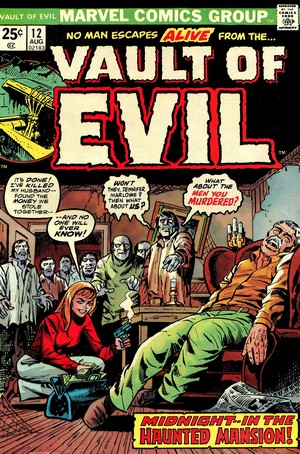
|
|
VAULT
OF EVIL #12
August 1974
(on
sale 8 times a year)
On Sale:
7 May 1974
Editor
-Roy Thomas
Cover - Larry Lieber (pencils) &
Vince Colletta (inks)
Vault of Evil
was launched in February 1973 as an
anthology title and, for the entirety of
its 23 issues run, generally featured
four horror stories, all of which were
reprinted from Marvel titles from the
mid- to late 1950s.
By that time, even
Marvel's anthology horror titles that had
carried original material had been
reduced to all-reprint titles, but a
nifty way of embellishing the
"vintage" quality of the
contents of Marvel's horror anthology
titles on the news stands was to package
it all behind brand new covers.
Commonly based on the
first story reprinted, they certainly
added some "buy this comic
book" oomph, even though they often
only had a very loose connection to the
actual contents featured on the inside
pages. The artwork
for those horror anthology title covers
was entrusted to some of the best cover
artists Marvel had throughout the Silver
and Bronze Age as well as some newly
emerging talent.
|
|
|
| |
| Vault of Evil thus saw
the work of Gil Kane, Bill Everett, Larry Lieber, Frank
Brunner, Rich Buckler, Russ Heath, Ed Hannigan and Ron
Wilson on pencils and Tom Palmer, Frank Giacoia, Mike
Esposito, Klaus Janson, Mike Ploog, John Romita, Ernie
Chan and Pablo Marcos on inks. The titles of all of Marvel's anthology
titles somewhat reflected the heritage of their contents
(which most commonly was reprinted stories from the
1950s), and even Marvel's advertising announcements
struck up that very same chord:
"VAULT OF EVIL #1:
You've wandered into the Chamber of Chills - and come
shuddering out of the Crypt of Shadows! Now, it's
time to enter - the Vault of Evil! Some of the
scariest spook-taculars of all!" (February
1973 Bullpen Bulletin)
The stories reprinted in Vault of Evil #12
are some of the more obscure material that Marvel dug up
for its horror reprint titles - only one story is
attributed to the artist (Fred Kida), and whilst
individuals with specialist knowledge have been able over
time to identify the other artists involved, the writers
remain unknown. But even if the
stories had featured full credits, most if not all of the
names would not have meant much to readers in 1974.
|
| |
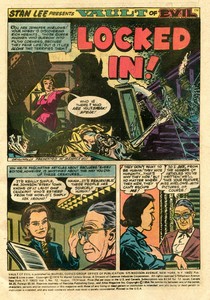 |
|
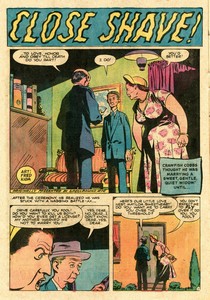 |
|
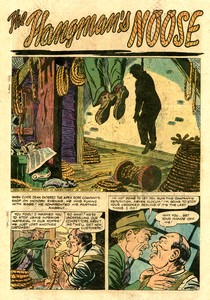 |
|
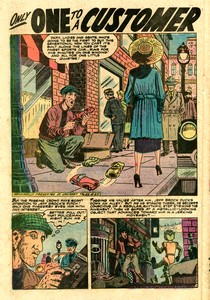 |
| |
|
|
|
|
|
|
"Locked
in!"
(5 pages)
originally published in
Menace #11
(May 1954)Pencils - Bob Powell
Inks - Bob Powell
Author,
Letterer and Colourist unknown
|
|
"Close
Shave!"
(5 pages)
originally published in
Spellbound #14
(April 1953)Pencils - Fred Kida
Inks - Fred Kida
Author,
Letterer and Colourist unknown
|
|
"The
Hangman's Noose"
(5 pages)
originally published in
Adventures into Terror #12
(October 1952)Pencils - Ed Winiarski
Inks - Ed Winiarski
Author,
Letterer and Colourist unknown
|
|
"Only One to
a Customer"
(5 pages)
originally published in
Uncanny Tales #29
(February 1955)Pencils - Sy Moskowitz
Inks - Sy Moskowitz
Author,
Letterer and Colourist unknown
|
|
| |
| Fred Kida (credited as
artist for "Close Shave" from
1953) started out in the business
as inker and then artist in 1941, joined
Atlas (Marvel's predecessor) in 1952 for
a few years (including their horror
titles), and then returned to Marvel in
the early 1970s mostly as an inker on
titles such as Iron Man, Luke
Cage, Godzilla, and Marvel
UK's Captain Britain. Kida also
worked on the Spider-Man syndicated comic
strip in 1981-1986 and 1996-1997. Bob Powell (1916-1967)
was mostly known for his Golden Age work,
but did a few late stints for Marvel in
1965 on Giant-Man, Human Torch,
Daredevil and Hulk stories.
Ed Winiarski (1911-1975) started out
as a cartoon-movie animator before
becoming part of the first generation of
Golden Age comic book artists; he
produced a number of horror stories for
Atlas in the 1950s.
|
|

Fred
Kida
(1920-2014)
|
|
|
| |
| Very little is known about Seymour "Sy"
Moskowitz, who seems to have been active in the comic
book industry for a short spell only during the
mid-1950s. |
| |
| The stories in Vault of
Evil #12 all follow the usual (think EC Comics)
"tale with a twist" pattern, of which "The
Hangman's Noose" is a prime example: businessman
cuts himself extra profits by using cheap materials for
his rope factory, gets called out by his partner who
threatens to expose him, chokes said partner and decides
to kill him by making it look like suicide by hanging,
but as soon as he leaves the scene the rope he used, made
from crappy material, breaks and the partner lives to
tell the police all about it. Stan Lee himself would
refer to these as "O. Henry stories" (Lee &
Mair, 2002), referencing the famous short stories by
William
Sydney Porter (writing under the pseudonym of O. Henry)
which almost always featured surprise endings. Most of
the reprinted stories in Marvel's anthology titles would
then add more or less of a supernatural twist to this
plot template. |
| |
 |
|
As a 12
or 13 year old back in the
mid-1970s I used to quite enjoy
these reprint horror stories,
even though it was clear to me
even back then that I wasn't
looking at what I considered the
"usual Marvel
standard". Today, it seems
fair to say that this material
hasn't aged well - not even some
nostalgic tickle for this kind of
material can prevent an overall
feeling of disappointment. |
|
|
|
| |
 |
|
For obvious
reasons, Marvel's reprint horror
titles did not run letters pages. Fred
Kida would later work on Marvel
UK's Captain
Britain stories.
|
|
|
|
| |
| |
|
| |
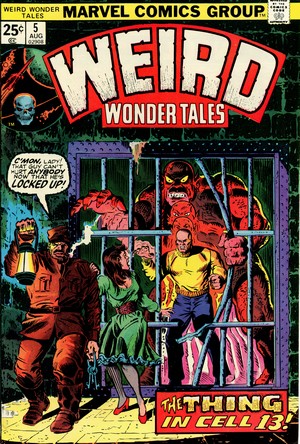
|
|
WEIRD WONDER
TALES #5
August 1974
(bi-monthly)
On Sale:
30 April 1974
Editor -Roy
Thomas
Cover - Larry Lieber (pencils),
Al Milgrom (inks)
Weird Wonder
Tales was launched in
December 1973 and, like Vault
of Evil, originally featured
three or four short stories per
issue, all of which were
reprinted from Marvel titles from
the mid- to late 1950s.
"We've
a couple of other new mags
debuting this go-round, too,
for those of you who simply
can't get enough of our
macabre mystery-type
thrillers. Don't miss your
collector's-item editions of
a trio of winners called
UNCANNY TALES, THE DEAD OF
NIGHT, and WEIRD WONDER
TALES! The latter,
incidentally, features
startling sagas of a more
science-fiction nature, drawn
by some of comicdom's
finest!" (Marvel
Comics March 1973 Bullpen
Bulletin)
The material
reprinted in Weird Wonder
Tales was indeed mostly
concerned with aliens rather than
ghosts and ghouls, and it did
frequently contain some classic
artwork by the likes of Steve
Ditko or John Romita.
|
|
|
|
| |
| Weird Wonder Tales also stood out a bit due
to the fact that as of issue #19 (December 1976) the
title switched gears to a degree, by reprinting the
Doctor Droom story from Amazing Adventures #1
from June 1961. Renaming the character "Doctor
Druid" (in order to avoid confusion with Doctor
Doom), the original material was heavily edited but
heralded more Doctor Druid stories for the remaining
three issues of Weird Wonder Tales, the final
two of which were reprints of stand-alone stories altered
in order to include the character. Issue #22 (May 1977)
was the final issue, as cancellation hit yet another of
Marvel's horror anthology reprint title. Weird
Wonder Tales #5 was, of course, still a long way off
from those changes, and featured the standard reprint
formula.
|
| |
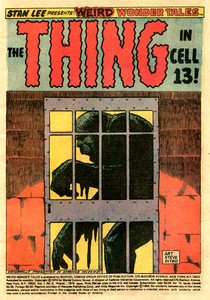 |
|
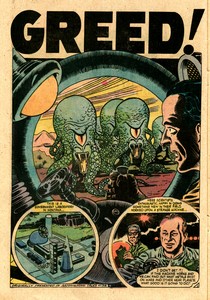 |
|
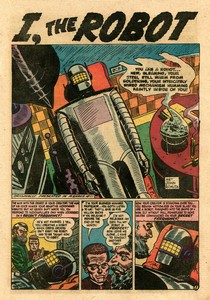 |
|
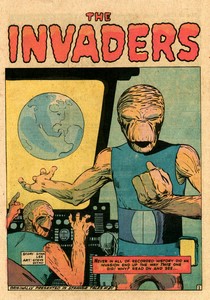 |
| |
|
|
|
|
|
|
"The Thing in
Cell 13!"
(5 pages)
originally published in
Strange Tales #81
(February 1961)Script - Stan Lee
Pencils - Steve Ditko
Inks - Steve Ditko
Letterer
and Colourist unknown
|
|
"Greed!"
(5 pages)
originally published in
Astonishing #36 *
(December 1954)Pencils - Pete Tumlinson
Inks - Pete Tumlinson
Author,
Letterer and Colourist unknown
* reprint
source erroneously given as Astonishing Tales
#36
|
|
"I, the
Robot"
(5 pages)
originally published in
Menace #11
(May 1954)Pencils - John Romita
Inks - John Romita
Author,
Letterer and Colourist unknown
|
|
"The
Invaders"
(5 pages)
originally published in
Tales to Astonish #34
(August 1962)Script - Stan Lee
Pencils - Steve Ditko
Inks - Steve Ditko
Lettering - Artie Simek
Colourist
unknown
* reprint
source erroneously given as
Strange
Tales #81
|
|
| |
The editorial perspective
regarding horror titles by that time was quantity over
quality, as Roy Thomas (who was officially in charge)
freely admits with regard to the very little time devoted
to most individual titles:
"We just had so
many we weren't paying much attention, and were just
sort of throwing them out." (Cooke, 2001)
|
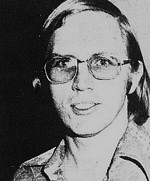
Roy
Thomas
|
|
This lack of editorial attention
is quite evident in Weird Wonder Tales
#5, as no less than two out of the four stories
reprinted featured wrong indications as to where
the material had been published before.
"Maybe if I
- and later Marv and Len - if we'd kept on
top of everything - but it was just such an
awful lot of work, and so some of it just
kind of got away from us." (Cooke,
2001)
In the end, the non-superhero reprint titles
were little more than fillers in an attempt to
gain market share - or, maybe even more
importantly, prevent the competition from doing
so.
"We did
flood the market (...) and DC would have to
match it (...) lots of stuff came out in the
'70s because of this approach." (Cooke,
2001)
|
|
| |
| All four stories reprinted in Weird Wonder Tales
#5 concern themselves with actual or attempted visits or
even invasions of aliens, and as such offer little to no
variety. |
| |
 |
|
However, anyone
familiar with the Simpsons TV series
will immediately be struck by the resemblance of
the Martians in "Greed" and the aliens
appearing regularly in the Simpson's annual
Halloween specials Treehouse of Terror.
Supposedly the inspiration came
to the Simpsons creators from an EC Comics cover,
but a search on comics.org reveals nothing that
would immediately support that claim. So who
knows, maybe Simpsons fans have Pete Tumlinson
(1920-2008) to thank, whose work appeared from
the late 1940s through the 1950s in titles
published by Marvel's predecessors Timely and
Atlas.
Time has not been kind to Weird
Wonder Tales #5, the contents of which have
aged rather badly. But at least there is some
artwork by Steve Ditko and John Romita (albeit
certainly not their finest).
|
|
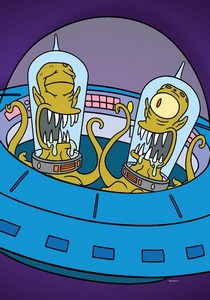 |
|
| |
| |
|
| |
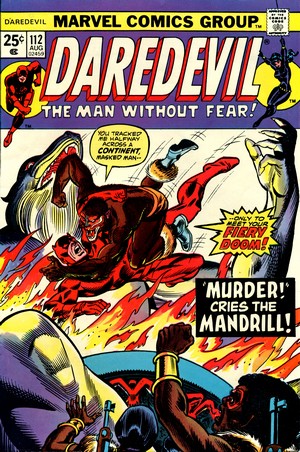
|
|
DAREDEVIL #112
August 1974
(monthly)
On Sale:
30 April 1974
Editor - Roy
Thomas
Cover - Gil Kane (pencils) &
Frank Giacoia (inks)
"'Death
of a Nation?" (18
pages)
Story
- Steve Gerber
Pencils - Gene Colan
Inks - Frank Giacoia
Lettering -
Annette
Kawecki, Gaspar Saladino
(splashpage)
Colouring - Petra Goldberg
STORY
OVERVIEW
- Daredevil
invades Black Spectre's airship
but is captured and finds himself
and Shanna the She-Devil guarded
by the brainwashed Black Widow
while Mandrill carries out his
plans, threatens to use nuclear
bombs, moves into the White
House, and takes over the US.
However, Daredevil successfully
breaks down the spell compelling
Black Widow and, with Shanna
joining them, they crash into the
Oval Office and take Mandrill
down for good.
|
|
|
|
| |
| Daredevil #112
concludes a fairly complex story arc that writer Steve
Gerber kick-started four issues prior, in Daredevil
#108 (March 1974). |
| |
Gerber, who knew fellow
comic book fan and St Louisan Roy Thomas,
had started working for Marvel in late
1972 and was moved around titles to learn
the ropes.
"In those
days, Daredevil was one of a couple
of books that were routinely assigned
to new writers. The book sold fairly
consistently, but not very well, so
there was nothing major at stake if
the writer flubbed it. It served as a
low-risk arena in which writers could
hone their craft. I had been writing
Iron Man for a while - another book
that was used the same way back then
- and was very eager to move on to
Daredevil." (Steve
Gerber in Mithra, 1997)
Gerber took over
from Gerry Conway as of Daredevil
#97 (March 1973, actually titled Daredevil
and the Black Widow), and after
scripting two issues together with Conway
was given sole author's reign as of issue
#99. He would stay on the title until
late 1974, co-plotting his final issue (Daredevil
#117, cover dated January 1975) with Dave
Cockrum, and his run remains a highlight
of the title.
|
|

Steve
Gerber
(1947-2008)
|
|
|
| |
| Steve Gerber would, of course, go on to become one of
the defining American comic book writers of the 1970s,
but he is certainly better known for his signature work
on Howard the Duck and Man-Thing than
his stint on Daredevil. |
| |
Initially Roy Thomas had hired
Steve Gerber with the idea of making him an
associate editor, but ended up focussing on
Gerber's strength: creativity.
"At the time, he wasn't a staff
kind of person, at least in terms of what
Marvel needed, but he was a real good writer
and did some interesting things"
(Roy Thomas in Amash, 2007)
His work on Daredevil, not unlike the
storylines he wrote for the Man Without Fear, has
multiple facets to it.
"There are germs of some fine
ideas herein, hints of an epic that could
have been more adequately explored, shades of
characterization worthy of bringing into
sharper focus (...) In Daredevil, we find
[Gerber as] a wordsmith beginning to find an
original voice and his work on the Man
Without Fear is just wild and weird enough to
be enjoyed as true artefacts of a medium that
was trying to grow up and have a say in this
strange and wondrous world."
(Cooke, 2015)
|
|
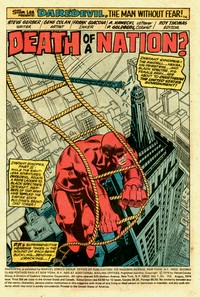 |
|
| |
| Other than the occasional change in writers, Daredevil
had also witnessed some truly major changes in terms of
storylines: As of issue #87 (May 1972), Gerry Conway had
moved the Man Without Fear to San Francisco (the first
major Marvel character to leave the confines of New York
City). |
| |
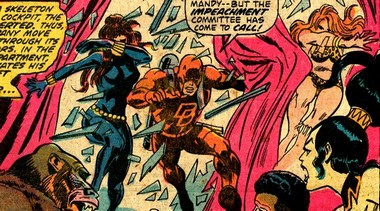 |
|
Matt Murdock had since returned
to the Big Apple three issues prior to Daredevil
#112, but he was still partnered with the Black
Widow (who had been a major reason for Murdock to
relocate to San Fran'). The former KGB spy had
also become Daredevil's logo-sharing co-star as
of Daredevil #92 (October 1972), which
actually was Daredevil and the Black Widow
#92. This title change stayed in place for 17
issues, after which things reverted back again to
the original as of Daredevil #108 (March
1974). The character roundel featuring the Black
Widow to the right of the cover logo would
however remain in place much longer and was only
dropped as of
Daredevil
#125 (September 1975).
|
|
| |
Gerber didn't much
care for Daredevil's co-star since it didn't match with
his take on the personalities of both Matt Murdock and
the Man Without Fear.
"If I
recall, Black Widow also left during my run on the
comic. And I have to say, in all honesty, I didn't
miss her. I think Daredevil works better as a loner.
One of the keys to understanding the Daredevil
character is that he's one man alone, in darkness.
Mitigate the totality of that darkness and the
character becomes much less interesting. Natasha was
a mitigating factor. However much I may have liked
looking at her, she just didn't belong in
Daredevil." (Steve
Gerber in Mithra, 1997)
One thing that remained
fairly consistent over quite some time with Daredevil,
however, was the artwork. Gene Colan had been an
oustanding and instantly recognizable asset to Marvel as
an incredible artist since the 1960s, and his lengthy run
on Daredevil made it one of his signature
series.
|
| |
| Colan had
first drawn the Man Without Fear for Daredevil
#20 (September 1966) and ended up
pencilling 91 issues between that first
assignment and Daredevil #370
(December 1997), with uninterrupted runs
between issues #20-#49, #53-#82 and
#84-#100 (in 1974 he also drew issues
#110, #112 and #116). Steve Gerber admired Gene
Colan's work, and in many ways they were
a perfect match.
"You have
to remember, Gene's style was very
unusual even for the 60s and 70s. He
was among the few artists at Marvel
who hadn't been hugely influenced by
Jack Kirby. Over the years, Gene did
manage to adopt certain elements of
Kirby's storytelling and apply them,
particularly to his action scenes,
but the way he draws is completely
different. Colan works with light and
shadow as much as he does with
outline. He's as concerned with the
people in a story as he is with its
action (...) I love his work."
(Steve
Gerber in Mithra, 1997)
|
|

Gene Colan
(1926-2011)
|
|
|
| |
Daredevil #112, being the climax end of a
multiple issues story arc, features plenty of action and
fight scenes, providing Colan with ample opportunities to
let his dynamic and cinematographic artwork fill up the
panels.
"Most of the
inspiration came from films and to me the movie
screen was just one gigantic comic book panel."
(Gene Colan in
Best, 2003)
|
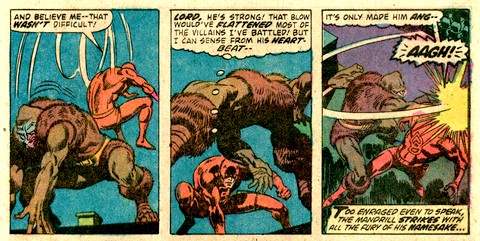 |
|
Gerry
Conway also enjoyed a positive and successful
collaboration with Gene Colan on the title.
"[Gene Colan's] contribution to
the kind of stories we told [in Daredevil] is
(...) dramatic." (Conway, 2015)
And Colan himself was in the flow of things
too.
"Every time
I did a job I was basically entertaining
myself, having a good time with it, and I
enjoyed that." (Gene Colan in Best,
2003)
|
|
| |
| Coming in at the end of a five part storyline has its
own ups and downs; you get to read the end, but you may
have no precise idea of what was going on previously. |
| |
| But then that's what editorial's
"instant recaps" on splash pages were
for, bringing you up to speed with the bare
necessities in order to at least have some
context. And that's exactly what the splash page
of Daredevil #112 did. This didn't exactly make
the MULTI-MAGS an ideal way of getting
your Marvel comic book fix. However, one needs to bear in
mind that this was a common fate of the average
comic book reader in the 1970s Bronze Age,
whether his or her comic books came packaged in a
plastic bag or as single issues from a display or
spinner rack. Back in those days, an
uninterrupted supply of specific titles was,
quite simply, not guaranteed.
Not worrying too much
about possible gaps in storylines thus became
something of a routine - it simply was a part of
being a comic book fan in the 1970s.
|
|
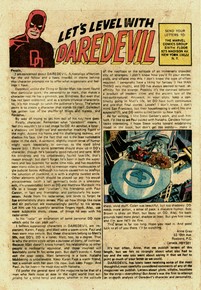 |
|
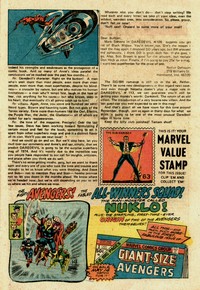 |
|
| |
|
| |
| Another aspect of being a
Marvel fan in the 1970s were the monthly Bullpen
Bulletins (which were the responsibility of the
editor-in-chief) and the in-house advertising (often with
mouth watering cover reproductions), and purchasers of
this MULTI-MAGS even got a two-for-one
regarding the Bulletins. The reason for this is both
simple and confusing at the same time - a bit like the
actual Bullpen Bulletins of that very period. Since all three titles contained
within that poly-bag carried an August cover date, one
would expect all of them to carry the August 1974 Bullpen
Bulletins - but that is not the case. Cover dates were
usually three months ahead of the actual on-sale date (to
lengthen their shelf life at the news agents if they
weren't snatched up quickly). therefore comic books with
an August 1974 cover date would usually have gone on sale
in May 1974 - which is the case for Vault of
Evil #12, and why we find an August 1974 Bullpen
Bulletins inside.
|
| |
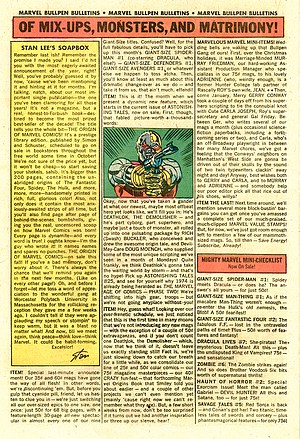
August 1974
Bullpen Bulletins and Bonus Page
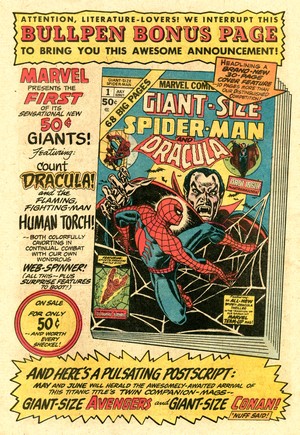
|
|
| Now for the confusing
part. While both Daredevil
#112 and Weird Wonder Tales #5
also carry August 1974 cover dates, they
actually went on sale the very last day of April
1974. This didn't affect the monthly Daredevil
#112, which also carried the August 1974
Bullpen Bulletins (not the least because
the previous issue of Daredevil had gone
on sale 2 April 1974), but the bi-monthly
Weird Wonder Tales #5, although
on sale on the same day as Daredevil
#112, had obviously come out of the
previous production month's cycle - and
therefore boasted a July 1974 Bullpen
Bulletin.
But that wasn't quite the end of it.
Marvel was announcing so many new titles
and concepts at the time that they
started to feature a second,
"bonus" Bullpen Bulletins page.
|
|
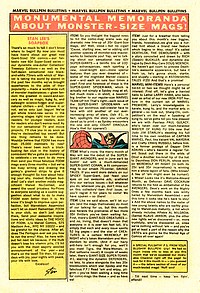
July
1974 Bullpen Bulletins
|
But confusingly enough, Weird
Wonder Tales #5 doesn't carry the bonus page
to go with the July 1974 Bullpen Bulletins, but
the one that complements the August 1974 Bullpen
Bulletins.
Readers of Weird Wonder Tales #5
would thus have noticed the back-and-forth dance
Marvel was doing on their new range of
double-sized editions within that single issue,
since the July Bullpen Bulletins advertised Super-Giant
Spider-Man #1 for 60˘ and the August Bonus
Page featured a full-page ad for Giant-Size
Spider-Man #1 for 50˘...
The latter half of 1974 was a period of utter
chaos at Marvel regarding pricing and title
announcements. Whilst this was bewildering to
some and amusing to others, the backlash of
throwing out more and more new titles would
become painfully visible in 1975, when creative
teams were thrown together and then torn apart
again almost on a monthly basis in order to
somehow get those titles out. This then was only
the shape of things yet to come...
As for the actual Bullpen Bulletins' contents,
the August 1974 edition pretty much contained
what its title promised: Of Mix-Ups,
Monsters, and Matrimony!
Stan's Soapbox lead the way with the "most
eagerly awaited announcement of the year"
- the planned publication in October 1974 of THE
ORIGINS OF MARVEL COMICS as a "prestige
library edition" in collaboration with
Simon and Schuster. The book would of course go
on to be a milestone event for Marvel and be an
actual game-changer, but readers were warned to "start
saving our shekels sahib" because "it
won't be cheap".
In the various ITEM! bullet points, the
confusion over the newly launched Giant-Size
line continues (as hinted at above), changing
over from 52 pages for 35˘ to 68 pages for 50˘.
|
|
| |
| Other than that, Deathlok is given a
spotlight plug for his first appearance in Astonishing
Tales #25, 1974 is hailed as "The
Second Age Of Marvel Comics", and no
less than two weddings (including Gerry Conway
marrying Carla Joseph) are relayed to readers. |
|
| |
 |
|
Some MARVEL MULTI-MAGS
were treasure troves, some less
so, but in terms of being
different (with one superhero,
one horror anthology and one
sci-fi anthology title, plus two
months' worth of Bullpen
Bulletins), this August 1974 MARVEL MULTI-MAGS
certainly stands out. |
|
|
|
| |
|
| |
| |
 |
|
Today,
any MARVEL MULTI-MAGS is a time
capsule; opening this plastic bag
right here offers a nostalgic
glimpse into what it was like to
be a comic book reader in August
1974. So what else
was going on back then?
|
|
|
|
| |
 |
|
John
Denver was at the top of
the US Billboard Chart in
early August 1974 with
"Annie's Song",
while the UK saw George
McCrae at number 1 with
his "Rock Your
Baby". |
|
|
|
| |
 |
|
The New
York Times Bestseller
list for August 1974 was
topped by John LeCarré's
"Tinker Tailor
Soldier Spy" - where
it would remain until
early October 1974. |
|
|
|
|
| |
 |
|
Monthly
stats are somewhat
unreliable when it comes
to movies, but the
highest grossing film in
the US in 1974 was
"The Towering
Inferno", which also
topped the British box
office that year. |
|
|
|
|
| |
 |
|
Popular
TV shows in the US in
1974 were "Little
House on the
Prairie",
"Happy Days",
"Rockford
Files" and "Six
Million Dollar Man",
while the UK's top
hitters in 1974 on TV
were
"Porridge",
"Sweeney" and
"Rising Damp". |
|
|
|
|
| |
|
|
| |
|
| |
|
| |
|
| |
BIBLIOGRAPHY
| |
| |
| AMASH Jim
(2007) "Roy Thomas Interview", Alter
Ego #70
BEST
Daniel (2003) "Gene Colan Interview", Internet Archive
(originally posted online at www.adelaidecomicsandbooks.com)
BREVOORT
Tom (2007) "Marvel Multi-Mags", Blah Blah
Blog, originally published online 28 April
2007, reposted 18 April 2020
CONWAY
Gerry (2015) "Matt and Natasha's San
Francisco Adventure", Marvel Masterworks
Daredevil, Vol. 9, Marvel
COOKE Jon
B. (2001) "Son of Stan: Roy's Years
of Horror", Comic Book Artist #13
COOKE
Jon B. (2015) "Lock Back in Angar", Marvel
Masterworks Daredevil, Vol. 10, Marvel
LEE Stan
& George MAIR (2002) Excelsior! The
Amazing Life of Stan Lee, Simon &
Schuster
MITHRA
Kuljit (1998) "Interview with Steve
Gerber",
manwithoutfear.com
|
|
| |
|
| |
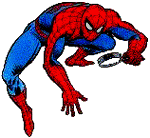

(c) 2023
uploaded
to the web 27 February 2023

|
| |
|
|





































